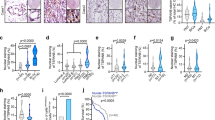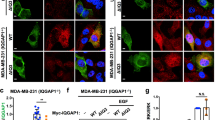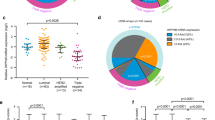Abstract
Protein kinase Cα (PKCα) can phosphorylate the epidermal growth factor receptor (EGFR) at threonine 654 (T654) to inhibit EGFR tyrosine phosphorylation (pY-EGFR) and the associated activation of downstream effectors. However, upregulation of PKCα in a large variety of cancers is not associated with EGFR inactivation, and factors determining the potential of PKCα to downregulate EGFR are yet unknown. Here, we show that ectopic expression of annexin A6 (AnxA6), a member of the Ca2+ and phospholipid-binding annexins, strongly reduces pY-EGFR levels while augmenting EGFR T654 phosphorylation in EGFR overexpressing A431, head and neck and breast cancer cell lines. Reduced EGFR activation in AnxA6 expressing A431 cells is associated with reduced EGFR internalization and degradation. RNA interference (RNAi)-mediated PKCα knockdown in AnxA6 expressing A431 cells reduces T654-EGFR phosphorylation, but restores EGFR tyrosine phosphorylation, clonogenic growth and EGFR degradation. These findings correlate with AnxA6 interacting with EGFR, and elevated AnxA6 levels promoting PKCα membrane association and interaction with EGFR. Stable expression of the cytosolic N-terminal mutant AnxA61–175, which cannot promote PKCα membrane recruitment, does not increase T654-EGFR phosphorylation or the association of PKCα with EGFR. AnxA6 overexpression does not inhibit tyrosine phosphorylation of the T654A EGFR mutant, which cannot be phosphorylated by PKCα. Most strikingly, stable plasma membrane anchoring of AnxA6 is sufficient to recruit PKCα even in the absence of EGF or Ca2+. In summary, AnxA6 is a new PKCα scaffold to promote PKCα-mediated EGFR inactivation through increased membrane targeting of PKCα and EGFR/PKCα complex formation.
This is a preview of subscription content, access via your institution
Access options
Subscribe to this journal
Receive 50 print issues and online access
$259.00 per year
only $5.18 per issue
Buy this article
- Purchase on Springer Link
- Instant access to full article PDF
Prices may be subject to local taxes which are calculated during checkout







Similar content being viewed by others
References
Pines G, Koestler WJ, Yarden Y . Oncogenic mutant forms of EGFR: lessons in signal transduction and targets for cancer therapy. FEBS Lett 2010; 584: 2699–2706.
Warren CM, Landgraf R . Signalling through ERBB receptors: multiple layers of diversity and control. Cell Signal 2006; 18: 923–933.
Ferguson KM . Structure-based view of epidermal growth factor receptor regulation. Annu Rev Biophys 2008; 37: 353–373.
Lanzetti L, Di Fiore PP . Endocytosis and cancer: an ‘insider’ network with dangerous liaisons. Traffic 2008; 9: 2011–2021.
Sorkin A, Goh LK . Endocytosis and intracellular trafficking of ErbBs. Exp Cell Res 2008; 314: 3093–3106.
Hunter T, Ling N, Cooper JA . Protein kinase C phosphorylation of the EGF receptor at a threonine residue close to the cytoplasmic face of the plasma membrane. Nature 1984; 311: 480–483.
Davis RJ, Czech MP . Platelet-derived growth factor mimics phorbol diester action on epidermal growth factor receptor phosphorylation at threonine-654. Proc Natl Acad Sci USA 1985; 82: 4080–4084.
Livneh E, Dull TJ, Berent E, Prywes R, Ullrich A, Schlessinger J . Release of a phorbol ester-induced mitogenic block by mutation at Thr-654 of the epidermal growth factor receptor. Mol Cell Biol 1988; 8: 2302–2308.
Friedman BA, van Amsterdam J, Fujiki H, Rosner MR . Phosphorylation at threonine-654 is not required for negative regulation of the epidermal growth factor receptor by non-phorbol tumor promoters. Proc Natl Acad Sci USA 1989; 86: 812–816.
Countaway JL, McQuilkin P, Girones N, Davis RJ . Multisite phosphorylation of the epidermal growth factor receptor. Use of site-directed mutagenesis to examine the role of serine/threonine phosphorylation. J Biol Chem 1990; 265: 3407–3416.
Bowen S, Stanley K, Selva E, Davis RJ . Constitutive phosphorylation of the epidermal growth factor receptor blocks mitogenic signal transduction. J Biol Chem 1991; 266: 1162–1169.
Morrison P, Takishima K, Rosner MR . Role of threonine residues in regulation of the epidermal growth factor receptor by protein kinase C and mitogen-activated protein kinase. J Biol Chem 1993; 268: 15536–15543.
Lund KA, Lazar CS, Chen WS, Walsh BJ, Welsh JB, Herbst JJ et al. Phosphorylation of the epidermal growth factor receptor at threonine 654 inhibits ligand-induced internalization and down-regulation. J Biol Chem 1990; 265: 20517–20523.
Bao J, Alroy I, Waterman H, Schejter ED, Brodie CH, Gruenberg J et al. Threonine phosphorylation diverts internalized epidermal growth factor receptors from a degradative pathway to the recycling endosome. J Biol Chem 2000; 275: 26178–26186.
Santiskulvong C, Rozengurt E . Protein kinase Calpha mediates feedback inhibition of EGF receptor transactivation induced by Gq-coupled receptor agonists. Cell Signal 2007; 19: 1348–1357.
Wang XQ, Yan Q, Sun P, Liu JW, Go L, McDaniel SM et al. Supression of epidermal growth factor receptor signaling by protein kinase C-alpha activation requires CD82, caveolin-1, and ganglioside. Cancer Res 2007; 67: 9986–9995.
Prevostel C, Alice V, Joubert D, Parker PJ . Protein kinase Çalpha̧ actively downregulates through caveolae-dependent traffic to an endosomal compartment. J Cell Sci 2000; 113: 2575–2584.
Steinberg SF . Structural basis of protein kinase C isoform function. Physiol Rev 2008; 88: 1341–1378.
Groves JT, Kuriyan J . Molecular mechanisms in signal transduction at the membrane. Nat Struct Mol Biol 2010; 17: 659–665.
Mochly-Rosen D . Localization of protein kinases by anchoring proteins: a theme in signal transduction. Science 1995; 268: 247–251.
Kheifets V, Mochly-Rosen D . Insight into intra- and inter-molecular interactions of PKC: design of specific modulators of kinase function. Pharm Res 2007; 55: 467–476.
Dubois T, Oudinet JP, Mira JP, Russo-Marie F . Annexins and protein kinases C. Biochim Biophys Acta 1996; 1313: 290–294.
Gerke V, Creutz CE, Moss SE . Annexins: linking Ca2+ signalling to membrane dynamics. Nat Rev Mol Cell Biol 2005; 6: 449–461.
Grewal T, Enrich C . Annexins - modulators of EGF receptor signalling and trafficking. Cell Signal 2009; 21: 847–858.
Kheifets V, Bright R, Inagaki K, Schechtman D, Mochly-Rosen D . Protein kinase C delta (deltaPKC)-annexin V interaction: a required step in deltaPKC translocation and function. J Biol Chem 2006; 281: 23218–23226.
Ron D, Mochly-Rosen D . Agonists and antagonists of protein kinase C function, derived from its binding proteins. J Biol Chem 1994; 269: 21395–21398.
Xu TR, Rumsby MG . Phorbol ester-induced translocation of PKC epsilon to the nucleus in fibroblasts: identification of nuclear PKC epsilon-associating proteins. FEBS Lett 2004; 570: 20–24.
Schmitz-Peiffer C, Browne CL, Walker JH, Biden TJ . Activated protein kinase C alpha associates with annexin VI from skeletal muscle. Biochem J 1998; 330: 675–681.
Rentero C, Evans R, Wood P, Tebar F, Vilà de Muga S, Cubells L et al. Inhibition of H-Ras and MAPK is compensated by PKC-dependent pathways in annexin A6 expressing cells. Cell Signal 2006; 218: 1006–1016.
Grewal T, Tebar F, Pol A, Enrich C . Involvement of targeting and scaffolding proteins in the regulation of the EGFR/Ras/MAPK pathway in oncogenesis. Curr Signal Transduct Ther 2006; 1: 147–167.
Clapéron A, Therrien M . KSR and CNK: two scaffolds regulating RAS-mediated RAF activation. Oncogene 2007; 26: 3143–3158.
McNulty DE, Li Z, White CD, Sacks DB, Annan RS . MAPK scaffold IQGAP1 binds the EGF receptor and modulates its activation. J Biol Chem 2011; 286: 15010–15021.
Davis AJ, Butt JT, Walker JH, Moss SE, Gawler DJ . The Ca2+-dependent lipid binding domain of P120GAP mediates protein-protein interactions with Ca2+-dependent membrane-binding proteins. Evidence for a direct interaction between annexin VI and P120GAP. J Biol Chem 1996; 271: 24333–24336.
Grewal T, Evans R, Rentero C, Tebar F, Cubells L, de Diego I et al. Annexin A6 stimulates the membrane recruitment of p120GAP to modulate Ras and Raf-1 activity. Oncogene 2005; 24: 5809–5820.
Vilà de Muga S, Timpson P, Cubells L, Evans R, Hayes TE, Rentero C et al. Annexin A6 inhibits Ras signalling in breast cancer cells. Oncogene 2009; 28: 363–377.
Pons M, Tebar F, Kirchhoff M, Peiró S, de Diego I, Grewal T et al. Activation of Raf-1 is defective in annexin 6 overexpressing Chinese hamster ovary cells. FEBS Lett 2001; 501: 69–73.
Blagoev B, Kratchmarova I, Ong SE, Nielsen M, Foster LJ, Mann M . A proteomics strategy to elucidate functional protein-protein interactions applied to EGF signaling. Nat Biotechnol 2003; 21: 315–318.
Grewal T, Koese M, Rentero C, Enrich C . Molecules in focus: Annexin A6 – regulator of the EGFR/Ras signalling pathway and cholesterol homeostasis. Int J Biochem Cell Biol 2010; 42: 580–584.
Enrich C, Rentero C, de Muga SV, Reverter M, Mulay V, Wood P et al. Annexin A6 – linking Ca(2+) signaling with cholesterol transport. Biochim Biophys Acta 2011; 1813: 935–947.
Sakwe AM, Koumangoye R, Guillory B, Ochieng J . Annexin A6 contributes to the invasiveness of breast carcinoma cells by influencing the organization and localization of functional focal adhesions. Exp Cell Res 2011; 317: 823–837.
King CS, Cooper JA . Effects of protein kinase C activation after epidermal growth factor binding on epidermal growth factor receptor phosphorylation. J Biol Chem 1986; 261: 10073–10078.
Iwashita S, Fox CF . Epidermal growth factor and potent phorbol tumor promoters induce epidermal growth factor receptor phosphorylation in a similar but distinctively different manner in human epidermoid carcinoma A431 cells. J Biol Chem 1984; 259: 2559–2567.
Fabbro D, Küng W, Roos W, Regazzi R, Eppenberger U . Epidermal growth factor binding and protein kinase C activities in human breast cancer cell lines: possible quantitative relationship. Cancer Res 1986; 46: 2720–2725.
Kim J, Thorne SH, Sun L, Huang B, Mochly-Rosen D . Sustained inhibition of PKCα reduces intravasation and lung seeding during mammary tumor metastasis in an in vivo mouse model. Oncogene 2011; 30: 323–333.
Collazos A, Michael N, Whelan RD, Kelly G, Mellor H, Pang LC et al. Site recognition and substrate screens for PKN family proteins. Biochem J 2011; 438: 535–543.
Rikova K, Guo A, Zeng Q, Possemato A, Yu J, Haack H et al. Global survey of phosphotyrosine signaling identifies oncogenic kinases in lung cancer. Cell 2007; 131: 1190–1203.
Smythe E, Smith PD, Jacob SM, Theobald J, Moss SE . Endocytosis occurs independently of annexin VI in human A431 cells. J Cell Biol 1994; 124: 301–306.
de Diego I, Schwartz F, Siegfried H, Dauterstedt P, Heeren J, Beisiegel U et al. Cholesterol modulates the membrane binding and intracellular distribution of annexin 6. J Biol Chem 2002; 277: 32187–32194.
Cubells L, Vilà de Muga S, Tebar F, Wood P, Evans R, Ingelmo-Torres M et al. Annexin A6-induced alterations in cholesterol transport and caveolin export from the Golgi complex. Traffic 2007; 8: 1568–1589.
Orth JD, Krueger EW, Weller SG, McNiven MA . A novel endocytic mechanism of epidermal growth factor receptor sequestration and internalization. Cancer Res 2006; 66: 3603–3610.
Stewart JR, O’Brien CA . Protein kinase C-(alpha) mediates epidermal growth factor receptor transactivation in human prostate cancer cells. Mol Cancer Ther 2005; 4: 726–732.
Tebar F, Villalonga P, Sorkina T, Agell N, Sorkin A, Enrich C . Calmodulin regulates intracellular trafficking of epidermal growth factor receptor and the MAPK signaling pathway. Mol Biol Cell 2002; 13: 2057–2068.
Grewal T, Heeren J, Mewawala D, Schnitgerhans T, Wendt D, Salomon G et al. Annexin VI stimulates endocytosis and is involved in the trafficking of LDL to the prelysosomal compartment. J Biol Chem 2000; 275: 33806–33813.
Cubells L, Vilá de Muga S, Tebar F, Bonventre JV, Balsinde J, Pol A et al. Annexin A6-induced inhibition of cytoplasmic phospholipase A2 is linked to caveolin export from the Golgi. J Biol Chem 2008; 283: 10174–10183.
Stern KA, Visser Smit GD, Place TL, Winistorfer S, Piper RC, Lill NL . Epidermal growth factor receptor fate is controlled by Hrs tyrosine phosphorylation sites that regulate Hrs degradation. Mol Cell Biol 2007; 27: 888–898.
Monastyrskaya K, Babiychuk EB, Hostettler A, Wood P, Grewal T, Draeger A . Plasma membrane-associated annexin A6 reduces Ca2+ entry by stabilizing the cortical actin cytoskeleton. J Biol Chem 2009; 284: 17227–17242.
Reverter M, Rentero C, de Muga SV, Alvarez-Guaita A, Mulay V, Cairns R et al. Cholesterol transport from late endosomes to the Golgi regulates t-SNARE trafficking, assembly, and function. Mol Biol Cell 2011; 22: 4108–4123.
Apolloni R, Prior IA, Lindsay M, Parton RG, Hancock JF . H-ras but not K-ras traffics to the plasma membrane through the exocytic pathway. Mol Cell Biol 2000; 20: 2475–2487.
Faux MC, Rollins EN, Edwards AS, Langeberg LK, Newton AC, Scott JD . Mechanism of A-kinase-anchoring protein 79 (AKAP79) and protein kinase C interaction. Biochem J 1999; 343 (Pt 2): 443–452.
Gold MG, Stengel F, Nygren PJ, Weisbrod CR, Bruce JE, Robinson CV et al. Architecture and dynamics of an A-kinase anchoring protein 79 (AKAP79) signaling complex. Proc Natl Acad Sci USA 2011; 108: 6426–6431.
Freye-Minks C, Kretsinger RH, Creutz CE . Structural and dynamic changes in human annexin VI induced by phosphorylation-mimicking mutation T356D. Biochemistry 2003; 42: 620–630.
Minashima T, Small W, Moss SE, Kirsch T . Intracellular modulation of signaling pathways by Annexin A6 regulates terminal differentiation of chondrocytes. J Biol Chem 2012; 287: 14803–14815.
Theobald J, Hanby A, Patel K, Moss SE, Annexin VI . has tumour-suppressor activity in human A431 squamous epithelial carcinoma cells. Br J Cancer 1995; 71: 786–788.
Johannsdottir HK, Jonsson G, Johannesdottir G, Agnarsson BA, Eerola H, Arason A et al. Chromosome 5 imbalance mapping in breast tumors from BRCA1 and BRCA2 mutation carriers and sporadic breast tumors. Int J Cancer 2006; 119: 1052–1060.
Pierga JY, Reis-Filho JS, Cleator SJ, Dexter T, Mackay A, Simpson P et al. Microarray-based comparative genomic hybridisation of breast cancer patients receiving neoadjuvant chemotherapy. Br J Cancer 2007; 96: 341–351.
Boultwood J, Fidler C, Strickson AJ, Watkins F, Gama S, Kearney L et al. Narrowing and genomic annotation of the commonly deleted region of the 5q- syndrome. Blood 2002; 99: 4638–4641.
Strzelecka-Kiliszek A, Buszewska ME, Podszywalow-Bartnicka P, Pikula S, Otulak K, Buchet R et al. Calcium- and pH-dependent localization of annexin A6 isoforms in Balb/3T3 fibroblasts reflecting their potential participation in vesicular transport. J Cell Biochem 2008; 104: 418–434.
Podszywalow-Bartnicka P, Kosiorek M, Piwocka K, Sikora E, Zablocki K, Pikula S . Role of annexin A6 isoforms in catecholamine secretion by PC12 cells: distinct influence on calcium response. J Cell Biochem 2010; 111: 168–178.
Tonetti DA, Morrow M, Kidwai N, Gupta A, Badve S . Elevated protein kinase C alpha expression may be predictive of tamoxifen treatment failure. Br J Cancer 2003; 88: 1400–1402.
Frankel LB, Lykkesfeldt AE, Hansen JB, Stenvang J . Protein Kinase C alpha is a marker for antiestrogen resistance and is involved in the growth of tamoxifen resistant human breast cancer cells. Breast Cancer Res Treat 2007; 104: 165–179.
Assender JW, Gee JM, Lewis I, Ellis IO, Robertson JF, Nicholson RI . Protein kinase C isoform expression as a predictor of disease outcome on endocrine therapy in breast cancer. J Clin Pathol 2007; 60: 1216–1221.
Timpson P, Wilson AS, Lehrbach GM, Sutherland RL, Musgrove EA, Daly RJ . Aberrant expression of cortactin in head and neck squamous cell carcinoma cells is associated with enhanced cell proliferation and resistance to the epidermal growth factor inhibitor gefitinib. Cancer Res 2007; 67: 9304–9314.
Jaumot M, Hancock JF . Protein phosphatases 1 and 2A promote Raf-1 activation by regulating 14-3-3 interactions. Oncogene 2001; 20: 3949–3958.
Lladó A, Timpson P, Vilà de Muga S, Moretó J, Pol A, Grewal T et al. PKCδ and calmodulin regulate recycling from the early endosomes through Arp2/3 and cortactin. Mol Biol Cell 2008; 19: 17–29.
Acknowledgements
This study was supported by grants to TG from the National Health and Medical Research Council of Australia (NHMRC; 510293, 510294) and the University of Sydney (2010-02681). CE is supported by BFU2009-10335, Consolider-Ingenio CSD2009-00016 from Ministerio de Innovación, Ciencia y Tecnología and PI040236 from Fundació Marató TV3 (Barcelona, Spain). FT is supported by BFU2009-13526. RJD and AS would like to acknowledge funding from the NHMRC. PW is a recipient of a co-funded National Heart Foundation (NHF)/NHMRC postgraduate scholarship. CR is grateful to the Beatriu de Pinós fellowship (Generalitat de Catalunya). SV is thankful to Ministerio de Educación y Ciencia, Spain, (FPI mobility Program) for a short-term fellowship at the laboratory of TG (Sydney, Australia). MR and AA are supported by fellowships from Ministerio de Innovación, Ciencia y Tecnología. AS is supported by Early Career Fellowships from the Cancer Institute NSW and the National Breast Cancer Foundation.
Author information
Authors and Affiliations
Corresponding authors
Ethics declarations
Competing interests
The authors declare no conflict of interest.
Additional information
Supplementary Information accompanies the paper on the Oncogene website
Rights and permissions
About this article
Cite this article
Koese, M., Rentero, C., Kota, B. et al. Annexin A6 is a scaffold for PKCα to promote EGFR inactivation. Oncogene 32, 2858–2872 (2013). https://doi.org/10.1038/onc.2012.303
Received:
Revised:
Accepted:
Published:
Issue Date:
DOI: https://doi.org/10.1038/onc.2012.303
Keywords
This article is cited by
-
SUMOylation of AnxA6 facilitates EGFR-PKCα complex formation to suppress epithelial cancer growth
Cell Communication and Signaling (2023)
-
ANXA6: a key molecular player in cancer progression and drug resistance
Discover Oncology (2023)
-
Annexin A6 and NPC1 regulate LDL-inducible cell migration and distribution of focal adhesions
Scientific Reports (2022)
-
Exosomal annexin A6 induces gemcitabine resistance by inhibiting ubiquitination and degradation of EGFR in triple-negative breast cancer
Cell Death & Disease (2021)
-
A novel inhibitory anti-invasive MAb isolated using phenotypic screening highlights AnxA6 as a functionally relevant target protein in pancreatic cancer
British Journal of Cancer (2017)



